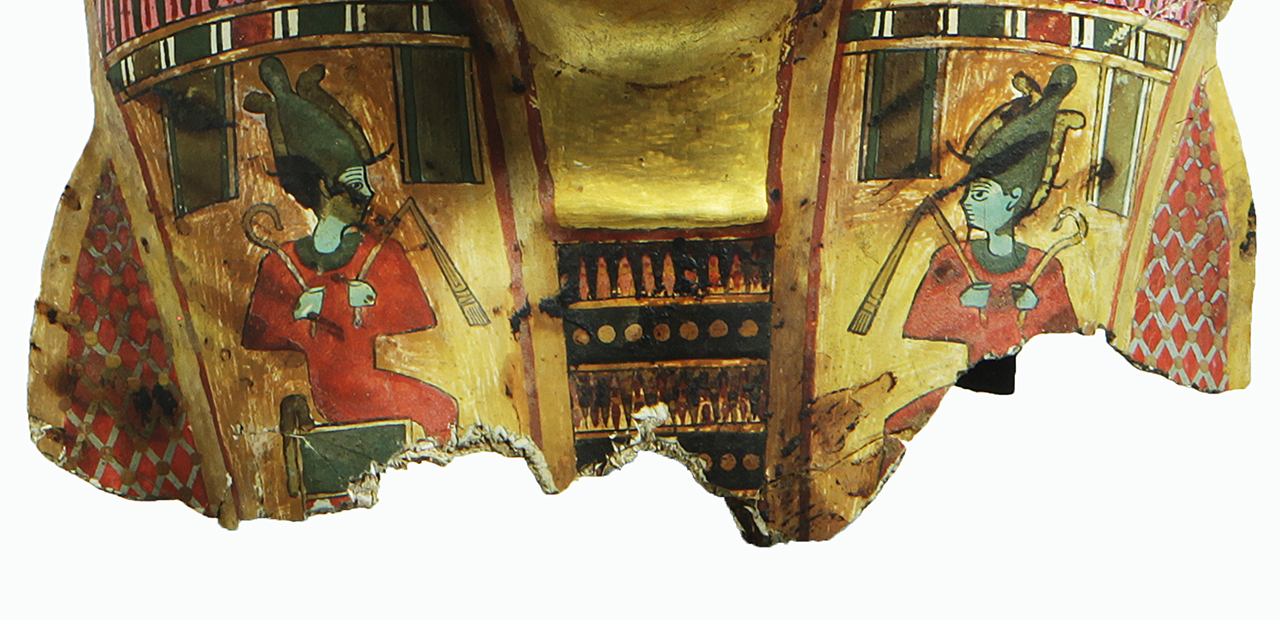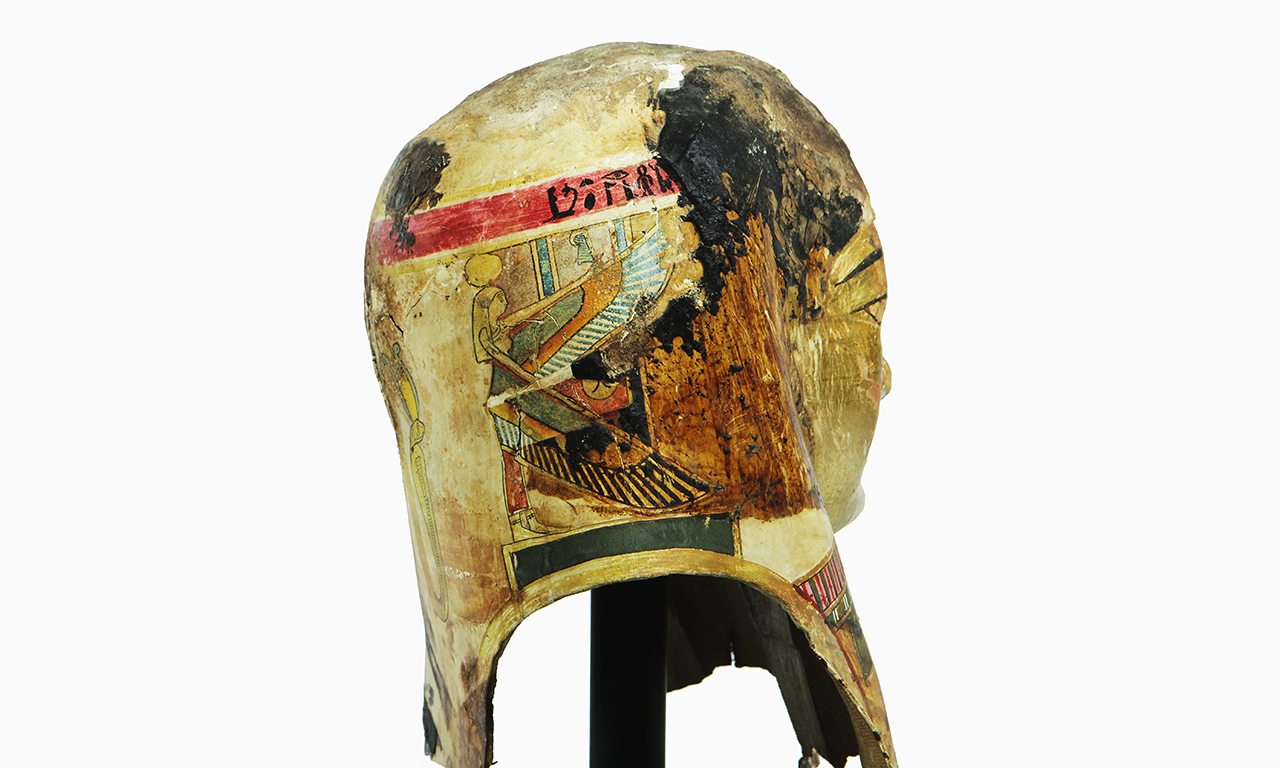2002 North Main Street
Santa Ana, California 92706
TEL: 714.567.3600
Hidden Visage: An Egyptian Mummy Cartonnage
 |
| Mummy Mask, 332 BCE-330 CE (late Ptolemaic to early Roman period) probably Faiyum Governorate, Egypt Linen, plaster, gold leaf and pigment; 15 × 12 3/4 × 10 1/2 in. 2003.38.1 Gift of Ramona Ward |
Trading Faces
The earliest Egyptians to enjoy the ornate decorations and elaborate funerary rites of being mummified were royalty. It was believed that they alone would become resurrected in a golden afterlife. Over the thousands of years in which ancient Egyptian civilization flourished, practices evolved until the point where wealthy citizens could also hope to spend their post-twilight years in a paradise. The cost for both royalty and private citizens was steep—a cartonnage such as this one made from gilded linen and plaster was very expensive—but these idealized visages were important for at least three reasons: they represented an individual’s hopes to become godly in their resurrected existence; the many parts of the soul scattered upon death needed to be able to recognize the face on a cartonnage to return to its body; and they served a protective function by invoking the gods and citing the name of the deceased. All of this was crucial for one’s success in the afterlife. In this post we explore how there is more than meets the eye with the iconography of one such mask in Bowers collections.

 |
| Detail of 2003.38.1 Gift of Ramona Ward |
A New Biz
Firstly, it is important to note that this mask dates to the late Ptolemaic to early Roman period. This was a time of great change in Egyptian society. Traditional practices faced a significant amount of external pressure from first the Greeks and later the Romans, and in many cases the decoration and iconography of mummies shifted drastically. At the same time, it was not uncommon for the symbols on mummy cartonnage to draw from imagery of the past thousand years. Gods like Osiris and Isis remained important in ritualistic rites. Osiris, the king of the underworld and the potent symbol of regeneration and rebirth, adorns the front left and right of the cartonnage. He sits holding his characteristic royal flail and crook and his skin is a muted green that evokes vegetation and renewal. As a legendary king and foundational figure of Egyptian mythology, it was Osiris’ resurrection that served as the basis for the belief that individuals could return in the afterlife.

 |
| Side view of 2003.38.1 Gift of Ramona Ward |
Welcome Ma’at
Osiris is not the only Egyptian deity to grace this cartonnage. The winged goddesses on both sides of the mask may represent the Sky goddess, Nut, who personified the vault of the heavens. Several images from the Ptolemaic period depict Nut as seen here with a disc shaped headdress and holding the goddess Ma’at’s feather of truth and justice. The dead were required to reconcile their actions in life before gaining entrance to the underworld. In the Hall of Judgment, Ma’at would weigh an individual’s heart against an ostrich feather on the scales of justice. The allusion to Ma’at may suggest the individual’s moral behavior and righteous actions in life will allow them to proceed smoothly to the afterlife. Between her outstretched wings is a symbol of the stars, suggesting the embrace of the universe and sky. Above the goddess are hieroglyphics which spell out the gender and name of the dead. They are partially obscured, but one expert believes this cartonnage belonged to a woman named ‘T(A)-ti-Wsir (pronounced Tetosiris).

 |
| Rear view of 2003.38.1 Gift of Ramona Ward |
Crown Jewels
The overall shape of the mask is that of crown encircling a face. The crown was an honorary attribute of royalty that anyone might possess on their cartonnage and lent credibility and righteousness to the individual’s status. Crowns might also be interpreted as the protective eye of the sun god and related to the protective function of Uraei, the cobras on the back of the mask. Because Uraei had the magic ability to spit fire, they excelled in warding against once’s enemies. Though it is difficult to see due to resin on this cartonnage, the top is decorated with the sun, a symbol of rebirth and renewal. Its circular shape suggested eternity and was used as headdress adornments on both human and animal deities as well as on its own in various aspects of funerary equipment from mummy cases to wall inscriptions.

 |
| Interior of 2003.38.1 Gift of Ramona Ward |
Beneath the Surface
Perhaps the best kept secret of this mask is that its interior hides a clear and chiseled three-dimensional face. This mask remains an important study piece because it is rare for mummy cartonnages to have significant facial impressions on their interior. Though the depiction may at first appear lifelike, closer inspection reveals its lines are highly geometricized. This indicates that the cartonnage may have been molded over a stone, wood, or clay head. There are currently no known molds of this type from this late period of Egyptian funerary art making. Intact mummy cases make it difficult to determine exactly how prevalent this practice was, so it remains a mystery how many cartonnage masks contain facial impressions inside. This hidden face is an important reminder that there is often something important lying just beneath the surface. There is a real value to being curious and taking a closer look.
Text and images may be under copyright. Based on original research by Julie Perlin Lee. Please contact Collection Department for permission to use. References are available on request. Information subject to change upon further research.

Comments